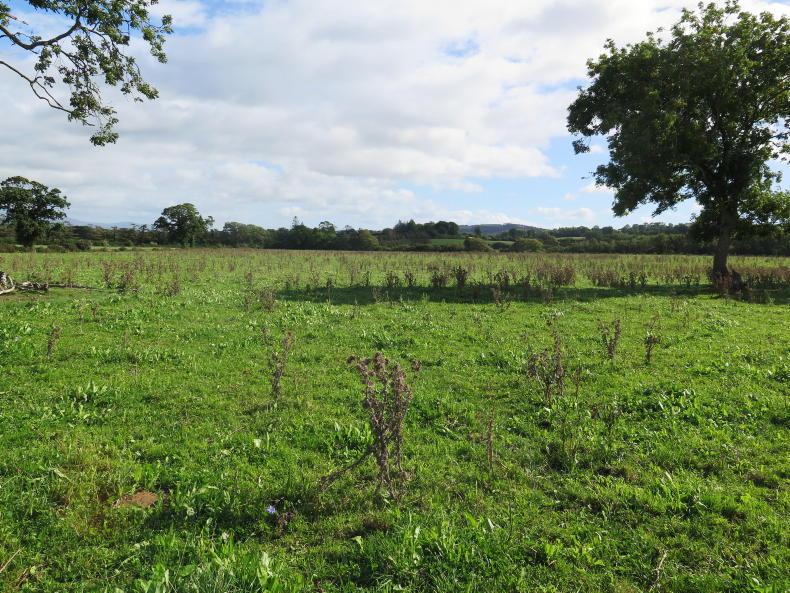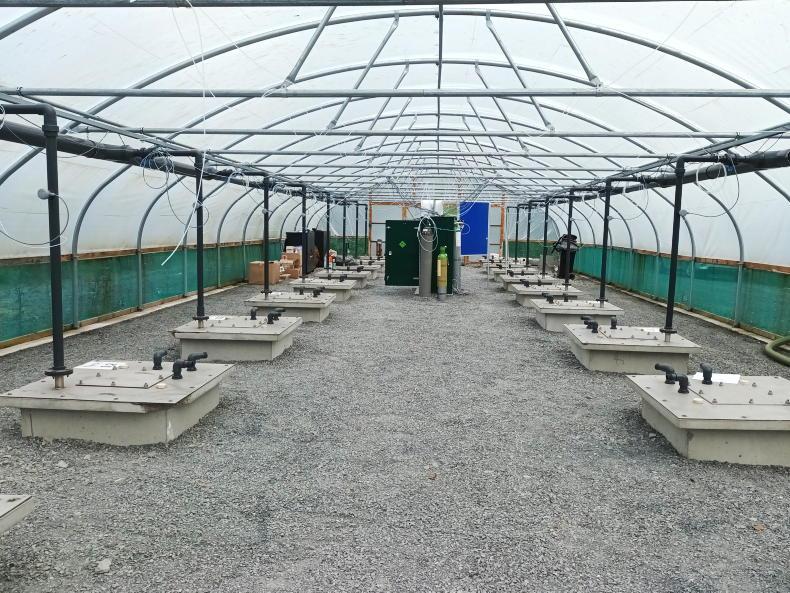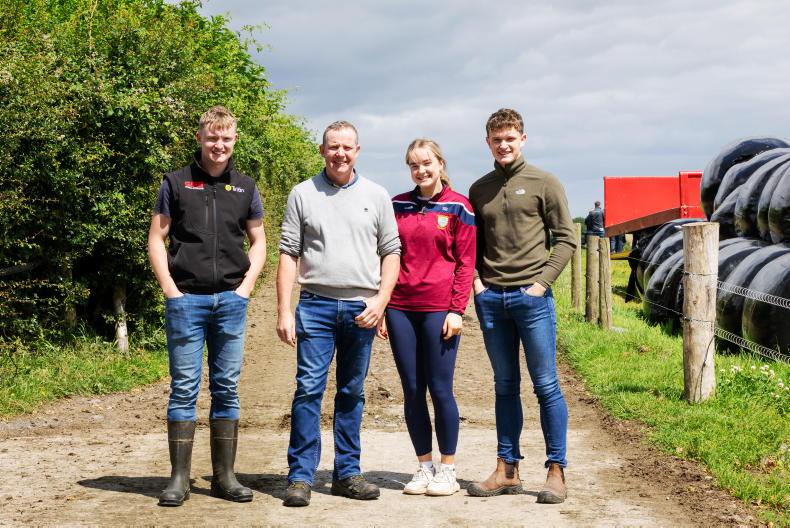While the majority of dairy farmers have reduced their use of chemical nitrogen this year, few have done so with as much gusto as the Foley family from Waterford.
To be fair, the Foleys started their nitrogen reduction journey in 2020, when just over 60kg N/ha was spread on the silage ground only. That was the last time synthetic nitrogen has been applied on their farm.
James and Clodagh Foley are milking 200 cows in a liquid milk system between Ballyduff and Lismore in west Waterford. They hosted a Macra field day last Saturday, attended by over 30 young farmers.
James says that the farm is in development mode; they have commenced the conversion to organics and they are in the process of commissioning a new 24 unit milking parlour and have just recently finished building a large extension to the existing cow shed.
The milking platform is a substantial holding with 260 acres of owned land in one square block. Soil type is mostly good and James says that at least 160 of the 260 acres would have been in tillage at one point.
A vein of land across the middle of the farm is heavier, peaty soil but it’s still very productive.
Outfarm
An 80 acre outfarm 20km away in Dungarvan is used for some of the heifer rearing and for silage making. The farm has traditionally been milking 200 cows, with 20-30% calving in the autumn.
Cow type is unusual for the area, being more of an extreme Holstein than the typical Holstein Friesian of the locality.
“Back in 2015 we would have delivered 10,000 litres of milk per cow and would have been feeding over 2t of meal per cow. We’re not pushing the cows as hard now and we’re feeding less meal.
"With the move to organics and our hope to be self-sufficient for feed I would be willing to look at lower yielding cows,” James says.
The move to organics was prompted by the fact that James says he could see that the farm was able to grow enough forage without the need for chemical nitrogen and phosphorus. The trigger moment for that was the introduction of multispecies swards.
The first multispecies was sown in 2018 after the drought. Four years later, the primary species are grass and white clover and a scattering of docks, but no more than in most grass only fields.
“The only weeds that I consider to be a problem now are thistles and ragwort. Cows eat everything else including docks. They used not eat docks before but since we cut out nitrogen they have started to eat them.
Someone told me that they are sour when they get nitrogen. You definitely have a better appreciation of plants and their function in soil after working with multispecies. Every plant has a function.”

This year multispecies has a lot of spear thistles in it.
The majority of the 18 or 19 species that were sown in the multispecies mixture in 2018 have died out. A handful of chicory plants remain and James dug one up to see the length of the tap root.
The red clover has died out, as has the plantain and the other herbs and legumes. Three grass species; ryegrass, cocksfoot and Timothy dominate, as does white clover.
The field got some chemical nitrogen in spring 2019 but got nothing since, only occasional slurry or dung.
Not diverse enough
Most multispecies mixtures being sown in Ireland contain five or six species, with cocksfoot and Timothy usually left out. James feels that this is a mistake as he says six species just aren’t diverse enough.
He says that even though there are little or no herbs left in the 2018 reseed, it is still performing well with the Timothy and cocksfoot growing well in early spring and during the recent dry spell.
He expects to go a full 10 years without having to reseed again; “OK, the quality of cocksfoot isn’t great but what I have found is that it holds its quality for longer. So rather than being on say a 21 day round in the mid-season, you could leave cocksfoot grow on for another week and have higher yields but quality would be the same, whereas you can’t get away with that if the field is full of perennial ryegrass.”
Almost 70 acres were sown to multispecies this year and about 50 acres sown to a combi-crop of wheat and beans which was cut for wholecrop silage. Beans being a legume provided nitrogen for the wheat.
This was direct drilled into an existing sward. Yield wasn’t measured before cutting, but James says he’s happy with the yield and plans to sow barley and peas in a combi-crop next year.
No silage was carried over from last year and no silage has been bought in. Meal is being fed and a derogation applies, meaning that the feed doesn’t have to be certified organic during the conversion phase but it does have to be GMO free.
A three way mix of barley, beans and beet pulp nuts is being fed now. A significant quantity of straw is being purchased annually for bedding.
Reseeds
Half of the reseeded fields this year were completed prior to going into organics and so Roundup was used to burn off the old sward. Both sections were disced before sowing.
Weed control has been an issue in some of these fields, with dying spear thistles very prevalent in one large field. James says that he missed the chance to top them in July but, but isn’t overly concerned because they are biennials so have a two-year life span.
James’ ambition is to use the combi-crops and multispecies to provide enough high quality silage to avoid the need to have to buy in expensive organic meal.
He wants to achieve this without reducing cow numbers, but will reduce stocking rate if he needs to. The overall stocking rate is a little less than 1.9 cows/ha so it’s a lot lower than most intensive dairy farmers, with more meal being fed than on most farms.
Comment
It’s obvious that maximising profit per hectare is not the main motivator for the Foleys, and that’s fine. If it was, then you could say that they should be milking 300 cows, feeding 500kg of meal and growing 14t or 15t/ha of pasture with say 150kg N/ha and white clover swards.
While I’ve no doubt that such a system would be profitable, the Foleys are trying something different and something that they believe in.
The multispecies swards are impressive, even those sown in 2018 are still performing well with no chemical nitrogen, albeit with a lot of what many would consider weed grasses.
The driver in these paddocks is the high clover content and of course you don’t need multispecies to have clover but there is definitely more of a performance boost from multispecies relative to just ryegrass and clover without chemical nitrogen.
Twelve months ago, Minister of State Pippa Hackett said in the Seanad that while visiting the Foley farm, she got a glimpse of the future of farming.
While Minister Hackett is an advocate for organic farming practices, if most other dairy farmers in Ireland did what James and Clodagh are doing now they would probably go broke.
Replicating this system would require a big reduction in stocking rate as the Foleys are probably growing around 10t DM/ha of pasture on land capable of growing 15t DM/ha with nitrogen.
Yes, savings would be made in fertiliser costs but the necessary drop in cow numbers would have a huge impact, particularly where there is labour, debt or land rent to be paid.
I don’t think organic dairy farming is the future, but I do think that conventional farmers will be adopting more organic practices such as multispecies to reduce reliance on bought in nitrogen and get more of the biological nitrogen.
While the majority of dairy farmers have reduced their use of chemical nitrogen this year, few have done so with as much gusto as the Foley family from Waterford.
To be fair, the Foleys started their nitrogen reduction journey in 2020, when just over 60kg N/ha was spread on the silage ground only. That was the last time synthetic nitrogen has been applied on their farm.
James and Clodagh Foley are milking 200 cows in a liquid milk system between Ballyduff and Lismore in west Waterford. They hosted a Macra field day last Saturday, attended by over 30 young farmers.
James says that the farm is in development mode; they have commenced the conversion to organics and they are in the process of commissioning a new 24 unit milking parlour and have just recently finished building a large extension to the existing cow shed.
The milking platform is a substantial holding with 260 acres of owned land in one square block. Soil type is mostly good and James says that at least 160 of the 260 acres would have been in tillage at one point.
A vein of land across the middle of the farm is heavier, peaty soil but it’s still very productive.
Outfarm
An 80 acre outfarm 20km away in Dungarvan is used for some of the heifer rearing and for silage making. The farm has traditionally been milking 200 cows, with 20-30% calving in the autumn.
Cow type is unusual for the area, being more of an extreme Holstein than the typical Holstein Friesian of the locality.
“Back in 2015 we would have delivered 10,000 litres of milk per cow and would have been feeding over 2t of meal per cow. We’re not pushing the cows as hard now and we’re feeding less meal.
"With the move to organics and our hope to be self-sufficient for feed I would be willing to look at lower yielding cows,” James says.
The move to organics was prompted by the fact that James says he could see that the farm was able to grow enough forage without the need for chemical nitrogen and phosphorus. The trigger moment for that was the introduction of multispecies swards.
The first multispecies was sown in 2018 after the drought. Four years later, the primary species are grass and white clover and a scattering of docks, but no more than in most grass only fields.
“The only weeds that I consider to be a problem now are thistles and ragwort. Cows eat everything else including docks. They used not eat docks before but since we cut out nitrogen they have started to eat them.
Someone told me that they are sour when they get nitrogen. You definitely have a better appreciation of plants and their function in soil after working with multispecies. Every plant has a function.”

This year multispecies has a lot of spear thistles in it.
The majority of the 18 or 19 species that were sown in the multispecies mixture in 2018 have died out. A handful of chicory plants remain and James dug one up to see the length of the tap root.
The red clover has died out, as has the plantain and the other herbs and legumes. Three grass species; ryegrass, cocksfoot and Timothy dominate, as does white clover.
The field got some chemical nitrogen in spring 2019 but got nothing since, only occasional slurry or dung.
Not diverse enough
Most multispecies mixtures being sown in Ireland contain five or six species, with cocksfoot and Timothy usually left out. James feels that this is a mistake as he says six species just aren’t diverse enough.
He says that even though there are little or no herbs left in the 2018 reseed, it is still performing well with the Timothy and cocksfoot growing well in early spring and during the recent dry spell.
He expects to go a full 10 years without having to reseed again; “OK, the quality of cocksfoot isn’t great but what I have found is that it holds its quality for longer. So rather than being on say a 21 day round in the mid-season, you could leave cocksfoot grow on for another week and have higher yields but quality would be the same, whereas you can’t get away with that if the field is full of perennial ryegrass.”
Almost 70 acres were sown to multispecies this year and about 50 acres sown to a combi-crop of wheat and beans which was cut for wholecrop silage. Beans being a legume provided nitrogen for the wheat.
This was direct drilled into an existing sward. Yield wasn’t measured before cutting, but James says he’s happy with the yield and plans to sow barley and peas in a combi-crop next year.
No silage was carried over from last year and no silage has been bought in. Meal is being fed and a derogation applies, meaning that the feed doesn’t have to be certified organic during the conversion phase but it does have to be GMO free.
A three way mix of barley, beans and beet pulp nuts is being fed now. A significant quantity of straw is being purchased annually for bedding.
Reseeds
Half of the reseeded fields this year were completed prior to going into organics and so Roundup was used to burn off the old sward. Both sections were disced before sowing.
Weed control has been an issue in some of these fields, with dying spear thistles very prevalent in one large field. James says that he missed the chance to top them in July but, but isn’t overly concerned because they are biennials so have a two-year life span.
James’ ambition is to use the combi-crops and multispecies to provide enough high quality silage to avoid the need to have to buy in expensive organic meal.
He wants to achieve this without reducing cow numbers, but will reduce stocking rate if he needs to. The overall stocking rate is a little less than 1.9 cows/ha so it’s a lot lower than most intensive dairy farmers, with more meal being fed than on most farms.
Comment
It’s obvious that maximising profit per hectare is not the main motivator for the Foleys, and that’s fine. If it was, then you could say that they should be milking 300 cows, feeding 500kg of meal and growing 14t or 15t/ha of pasture with say 150kg N/ha and white clover swards.
While I’ve no doubt that such a system would be profitable, the Foleys are trying something different and something that they believe in.
The multispecies swards are impressive, even those sown in 2018 are still performing well with no chemical nitrogen, albeit with a lot of what many would consider weed grasses.
The driver in these paddocks is the high clover content and of course you don’t need multispecies to have clover but there is definitely more of a performance boost from multispecies relative to just ryegrass and clover without chemical nitrogen.
Twelve months ago, Minister of State Pippa Hackett said in the Seanad that while visiting the Foley farm, she got a glimpse of the future of farming.
While Minister Hackett is an advocate for organic farming practices, if most other dairy farmers in Ireland did what James and Clodagh are doing now they would probably go broke.
Replicating this system would require a big reduction in stocking rate as the Foleys are probably growing around 10t DM/ha of pasture on land capable of growing 15t DM/ha with nitrogen.
Yes, savings would be made in fertiliser costs but the necessary drop in cow numbers would have a huge impact, particularly where there is labour, debt or land rent to be paid.
I don’t think organic dairy farming is the future, but I do think that conventional farmers will be adopting more organic practices such as multispecies to reduce reliance on bought in nitrogen and get more of the biological nitrogen.










SHARING OPTIONS